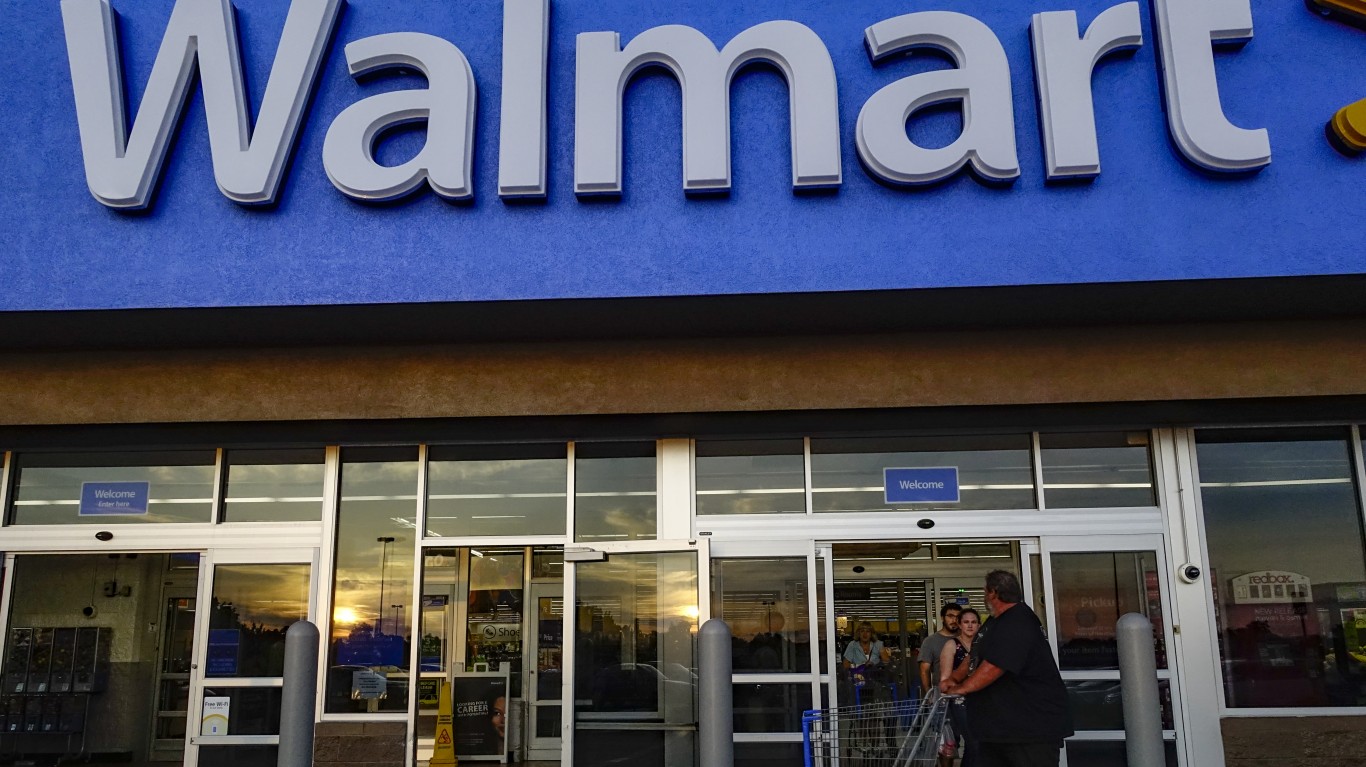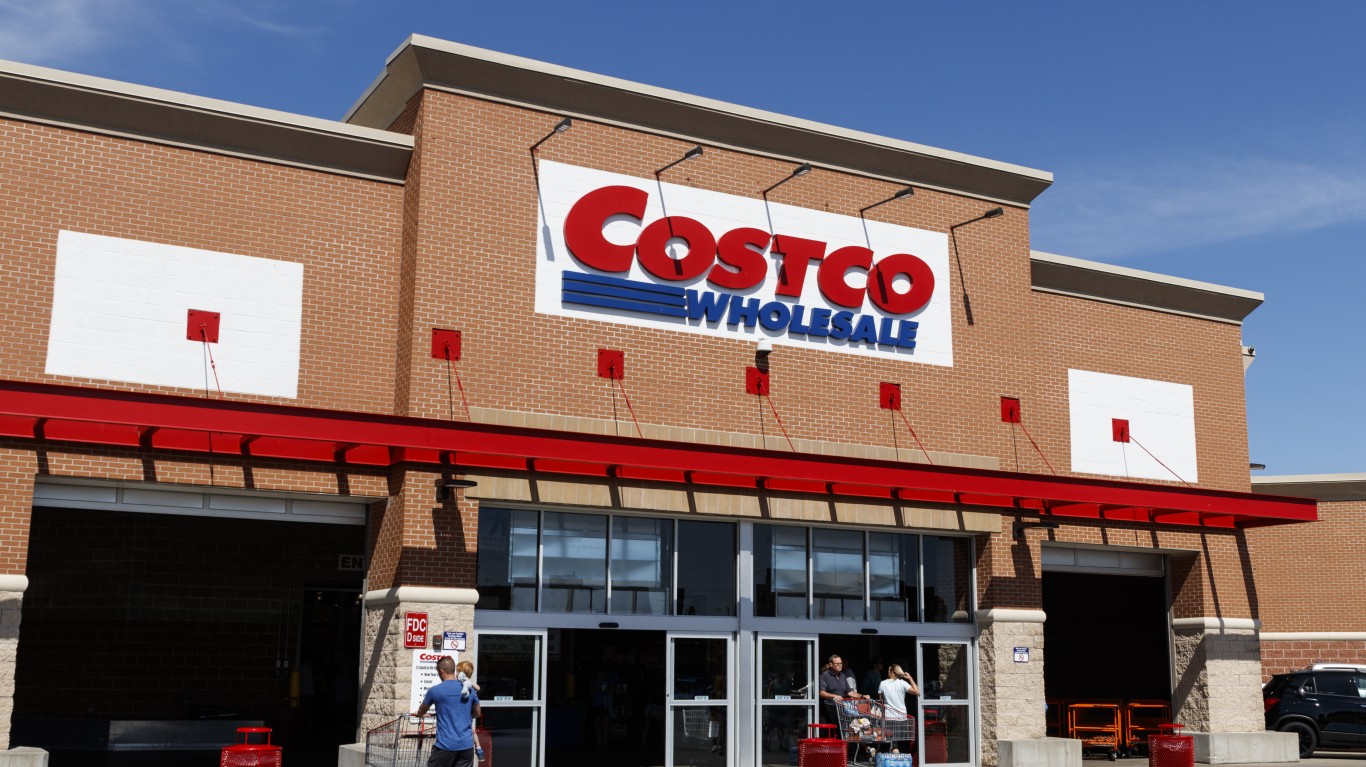
Walmart and Costco are two of the best stores to shop at for people looking to save money on groceries and home essentials. That being said, they both have very different approaches to getting consumers groceries, and those approaches influence the things that Walmart and Costco focus on. Is there one chain that stands out above the rest? Today, we are taking a look at Walmart vs Costco and compare them to determine where each of their strengths lie. Plus, it should help anyone trying to determine which store they should go to according to certain criteria or needs. Let’s get started.
To determine the pros and cons of both Walmart and Costco, 24/7 Wall Street used online pricing, established features for each store, location services, and editorial experience and discretion. (Read: The Biggest Grocery Store Chains in North America)
Walmart vs Costco: Overall Pricing

Looking at Walmart and Costco’s overall pricing is a little tough. Walmart offers what most would consider “standard” sizes of most goods, while Costco offers items exclusively in bulk. What this means is that to compare them, you need to look at the most granular prices listed on labels, usually cents/ounce or some other similar metric.
Removing all other factors, Walmart and Costco have almost negligible price differences in most of their products. Things like ground beef, chicken breast, and detergent are so close in price that the difference is usually a few cents after it’s all said and done. There are occasionally some products where Costco will earn the lowest price, and Heavenly Homemaker did a price comparison during a standard grocery run. Costco edged ahead on a few products, but it wasn’t a clean sweep.
Where there are some differences, however, is when you add in other factors. Since both of these stores have nearly identical pricing on their items, you have to consider the overall price of a Costco membership. Costco memberships run around $60 annually, which isn’t a huge cost, but it does technically make the overall shopping experience a little more expensive if you factor it in.
Additionally, Costco.com is known to be a little more expensive than shopping in person. This doesn’t usually apply to Walmart, and the prices listed online are going to be the ones you pay in the store.
Walmart vs Costco: Generic Brand (Great Value vs Kirkland)

One of the biggest differences between Walmart and Costco is their generically branded goods. Walmart’s brand is Great Value, while Costco’s brand is Kirkland Signature. From here on, things get a bit subjective.
Walmart’s Great Value is known to be one of the cheapest brands on store shelves, and Walmart will often undercut branded items with their pricing. That being said, general consumer sentiment is that certain Great Value branded items just aren’t as quality as their brand-name equivalents. Additionally, Great Value isn’t a real “innovator” when it comes to products, and it rarely has unique food items that people seek out en masse to “try”.
Costco, on the other hand, has done a great job cultivating its Kirkland Signature brand to become something of a household legend. Whether it’s Kirkland Liquor or frozen chicken mini knockoffs, the Kirkland brand has a ton of unique offerings, and most of the time, they are of fantastic quality. When it comes to generic branding, Costco definitely has a leg up here. (Read: Popular Discontinued Snack Foods We Really Miss)
Walmart vs Costco: Product Availability and Diversity

Both Walmart and Costco are huge warehouse-like stores, but when it comes to product availability and diversity of products, there is a clear winner.
Walmart has a “jack of all trades” approach to products. Essentially, they carry pretty much everything all the time. Car parts, groceries, books, electronics, name brand, off-brand, niche, specialty, and more, Walmart will usually carry it.
Costco, however, is much more selective with its products. You can’t find everything all the time at Costco, and if you go with a particular item or brand in mind, it’s very possible they simply don’t carry it. That being said, they do rotate things seasonally and will sometimes bring certain products in during certain high-demand times of the year.
Overall, if you want multiple brands and options of the same product, Walmart is going to be your best bet. Costco only carries a few brands, and they will often prioritize Kirkland if possible.
Walmart vs Costco: Standard vs Bulk Quantities

One of the major differences between Walmart and Costco is their approach to product size and quantity. Walmart carries what most would consider “standard” sizes, occasionally offering a large “family-sized” item now and again. Costco exclusively offers its items in bulk, with very few offerings being available in standard sizes.
As an example, let’s look at buying butter. At Walmart, you can buy a single package of butter, usually with four sticks, each a quarter pound. For most individuals and families, a single package of butter is enough to last for at least 2-3 weeks, and if you need more, buying two will guarantee you are set until your next shopping trip.
At Costco, the smallest standard butter they offer comes in a pack of four, each a pound. Unless you are going to freeze it, using four pounds of butter as an individual is really difficult, and even a family of 3-4 would struggle to use it all before it starts losing freshness. There are some other options available at Costco, but they are still in larger sizes than what is offered at Walmart. The Kirkland Signature Grass-Fed butter, for example, comes in 8oz, but it still comes in a pack of four.
This trend can be extrapolated to almost every product in the store. Milk? The smallest size is a gallon. Eggs? Only comes in a 24-count package. Bananas? 3 lbs. minimum. It goes on for most other things. For extremely large families, this could be a viable way to shop, but for almost everyone else, things will either be wasted or have to be somehow stored.
Walmart vs Costco: Store Locations

Walmart has a real advantage when it comes to store locations, except for a few specific regions. On top of that, Walmart has invested in some smaller locations known as “Neighborhood Markets” that operate like a standard grocery store and don’t have all the extras that a “Superstore” would. These smaller locations have a smaller footprint and help fill in the gaps where a traditional Walmart may be further away.
Costco usually places a single location for a region unless there is an extremely high population density. Additionally, Costco hasn’t expanded to every part of the United States yet, with Maine, Rhode Island, West Virginia, and Wyoming not having a single store.
On the flip side, Walmart is prevalent in almost every metropolis and can be found in remote areas where Costco would never consider placing a store. This is true for most places, except for New York City. New York is strangely devoid of Walmarts due to issues with union workers. Costco has four locations in the city.
Walmart vs Costco: In-Store Benefits
Both Walmart and Costco offer some competitive in-store benefits, some with physical locations and some online or through signups.
Walmart, for example, offers eyewear services, a true pharmacy, insurance and health centers, auto repair centers, photo services, money services, and more. Most of these benefits don’t require any sort of membership besides the standard signup process (like transferring prescriptions to the pharmacy or something). (Read: The 11 Things I Would Never Buy at Walmart)
Costco also offers some in-store benefits, all requiring at least a Costco membership, of course. Their offers include pharmacy access, business delivery, optical services, insurance, home improvement, and even travel benefits and deals.
Each business offers some similar features, although they do specialize a bit in some areas (Walmart into finance, Costco into travel, for example). There really isn’t one that is better than the other, just different offerings.
Along a slightly different vein, both stores also offer some form of in-store dining. Walmart usually does this through 3rd-party partnerships, namely those with Subway, McDonald’s, and Domino’s. Additionally, they are expanding restaurant offerings and have recently partnered with chains like Taco Bell, Nathan’s Famous, Frutta Bowls, and Saladworks, plus a few others.
Costco is definitely famous for its in-store dining, although its own products make up all of its offerings. Costco pizza, hotdogs, chicken bakes, and more have established Costco as a pitstop that many people look forward to. (Read: The 12 Things I Would Never Buy At Costco)
Again, neither is better, but if you have a preference towards a specific chain or product, it could make a difference in the shopping experience.
Walmart vs Costco: Price Matching

One of the major benefits that Walmart offers is the ability to price match against other retailers. Costco flatly doesn’t offer this, claiming:
“Please rest assured that your satisfaction is our top priority—that’s why we’re always working to bring you brand-name items at the lowest possible prices. However, because we already offer competitive prices at the point of purchase, we do not price match with other retailers. Aug 28, 2023” – Costco Customer Service
Walmart’s terms do vary according to stores and location, but it’s well-known to be extremely generous and a fantastic value-add.
Walmart vs Costco: Membership Fees

Another of the big differentiators between the two companies is the membership fees.
Currently, Walmart is totally free to shop at, and almost all of the in-store offerings don’t require a membership to access. A little more recently, Walmart has rolled out its own membership, although it’s not as built-out as Costco’s is. Dubbed “Walmart+“, the service gives free delivery, member pricing at fuel stations, mobile scan & go, and a few others.
Costco’s base-level membership (Gold Star Membership) is $60, and shoppers can’t access the store or any of its benefits without a membership card. They also offer two more tiers of membership. The Business Membership is $60, but it offers the ability to purchase for resale, plus the ability to add more cardholders for another $60. The next level up is the Executive Membership, which offers the same things as all the rest, plus 2% back on certain Costco purchases, special service options, and additional travel benefits.
Adding $60 a year to your grocery bill isn’t too excessive, but when you start adding the steep $120 membership fee, it does tip into a different category. For reference, an Amazon Prime membership is $139 when paid annually or $14.99 a month. Walmart is totally free, and if you want Walmart+, it adds an extra $49 a year or $6.47 a month.
Walmart vs Costco: Delivery

Walmart offers a pretty straightforward delivery system. For non-subscribers of Walmart+, that fee is up to $9.95, depending on regional variances. For existing subscribers, delivery is totally free on anything over $35. Additionally, Walmart doesn’t charge extra or markup groceries.
Costco doesn’t offer its own delivery services, but it has partnered with Instacart for delivery in certain zip codes. The minimum delivery fee for Costco is $35, although Instacart fees are added, plus a tip. Additionally, Costco will mark up certain items online compared to their in-store offerings.
In 20 Years, I Haven’t Seen A Cash Back Card This Good
After two decades of reviewing financial products I haven’t seen anything like this. Credit card companies are at war, handing out free rewards and benefits to win the best customers.
A good cash back card can be worth thousands of dollars a year in free money, not to mention other perks like travel, insurance, and access to fancy lounges.
Our top pick today pays up to 5% cash back, a $200 bonus on top, and $0 annual fee. Click here to apply before they stop offering rewards this generous.
Flywheel Publishing has partnered with CardRatings for our coverage of credit card products. Flywheel Publishing and CardRatings may receive a commission from card issuers.
Thank you for reading! Have some feedback for us?
Contact the 24/7 Wall St. editorial team.






